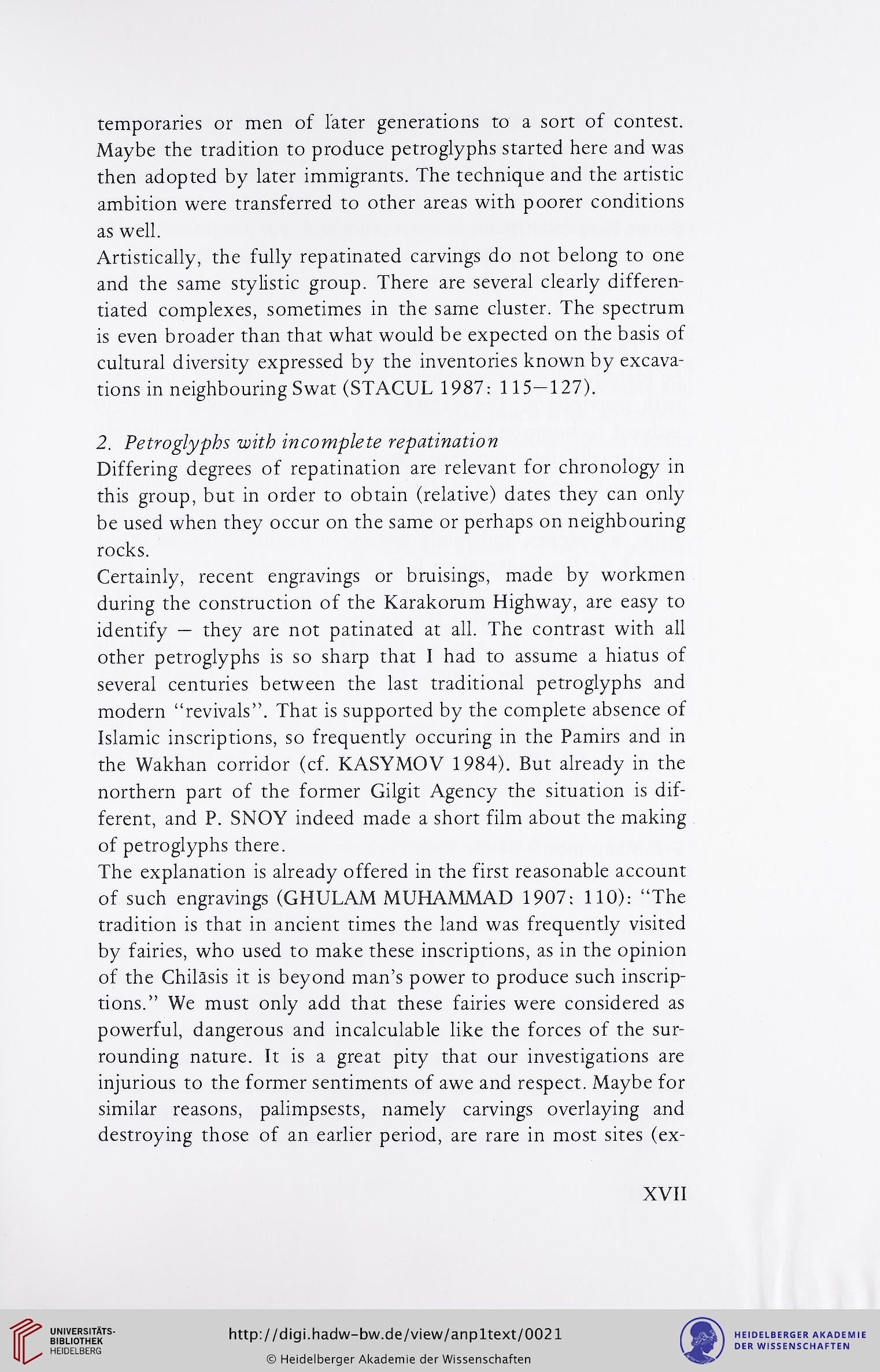temporaries or men of later generations to a sort of contest.
Maybe the tradition to produce petroglyphs started here and was
then adopted by later immigrants. The technique and the artistic
ambition were transferred to other areas with poorer conditions
as well.
Artistically, the fully repatinated carvings do not belong to one
and the same stylistic group. There are several clearly differen-
tiated complexes, sometimes in the same cluster. The spectrum
is even broader than that what would be expected on the basis of
cultural diversity expressed by the inventories known by excava-
tions in neighbouring Swat (STACUL 1987: 115—127).
2. mzTT?
Differing degrees of repatination are relevant for chronology in
this group, but in order to obtain (relative) dates they can only
be used when they occur on the same or perhaps on neighbouring
rocks.
Certainly, recent engravings or bruisings, made by workmen
during the construction of the Karakorum Highway, are easy to
identify — they are not patinated at all. The contrast with all
other petroglyphs is so sharp that I had to assume a hiatus of
several centuries between the last traditional petroglyphs and
modern "revivals". That is supported by the complete absence of
Islamic inscriptions, so frequently occuring in the Pamirs and in
the Wakhan corridor (cf. KASYMOV 1984). But already in the
northern part of the former Gilgit Agency the situation is dif-
ferent, and P. SNOY indeed made a short film about the making
of petroglyphs there.
The explanation is already offered in the first reasonable account
of such engravings (GHULAM MUHAMMAD 1907: 110): "The
tradition is that in ancient times the land was frequently visited
by fairies, who used to make these inscriptions, as in the opinion
of the Chilasis it is beyond man's power to produce such inscrip-
tions." We must only add that these fairies were considered as
powerful, dangerous and incalculable like the forces of the sur-
rounding nature. It is a great pity that our investigations are
injurious to the former sentiments of awe and respect. Maybe for
similar reasons, palimpsests, namely carvings overlaying and
destroying those of an earlier period, are rare in most sites (ex-
XVII
Maybe the tradition to produce petroglyphs started here and was
then adopted by later immigrants. The technique and the artistic
ambition were transferred to other areas with poorer conditions
as well.
Artistically, the fully repatinated carvings do not belong to one
and the same stylistic group. There are several clearly differen-
tiated complexes, sometimes in the same cluster. The spectrum
is even broader than that what would be expected on the basis of
cultural diversity expressed by the inventories known by excava-
tions in neighbouring Swat (STACUL 1987: 115—127).
2. mzTT?
Differing degrees of repatination are relevant for chronology in
this group, but in order to obtain (relative) dates they can only
be used when they occur on the same or perhaps on neighbouring
rocks.
Certainly, recent engravings or bruisings, made by workmen
during the construction of the Karakorum Highway, are easy to
identify — they are not patinated at all. The contrast with all
other petroglyphs is so sharp that I had to assume a hiatus of
several centuries between the last traditional petroglyphs and
modern "revivals". That is supported by the complete absence of
Islamic inscriptions, so frequently occuring in the Pamirs and in
the Wakhan corridor (cf. KASYMOV 1984). But already in the
northern part of the former Gilgit Agency the situation is dif-
ferent, and P. SNOY indeed made a short film about the making
of petroglyphs there.
The explanation is already offered in the first reasonable account
of such engravings (GHULAM MUHAMMAD 1907: 110): "The
tradition is that in ancient times the land was frequently visited
by fairies, who used to make these inscriptions, as in the opinion
of the Chilasis it is beyond man's power to produce such inscrip-
tions." We must only add that these fairies were considered as
powerful, dangerous and incalculable like the forces of the sur-
rounding nature. It is a great pity that our investigations are
injurious to the former sentiments of awe and respect. Maybe for
similar reasons, palimpsests, namely carvings overlaying and
destroying those of an earlier period, are rare in most sites (ex-
XVII




